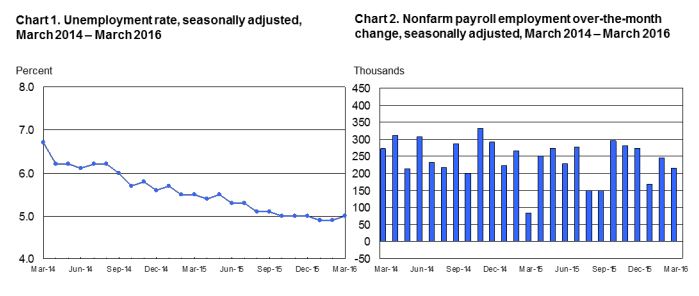 Nonfarm payrolls added 215,000 jobs in March, pushing the average monthly job gain for the first three months of the year up to 209,000, according to the March 2016 Employment Summary from the Bureau of Labor Statistics released on Friday.
Nonfarm payrolls added 215,000 jobs in March, pushing the average monthly job gain for the first three months of the year up to 209,000, according to the March 2016 Employment Summary from the Bureau of Labor Statistics released on Friday.
The unemployment rate inched upward (from 4.9 to 5.0 percent) and share of unemployed persons (8.0 percent) was little changed over-the-month in March.
While those numbers are positive, the March employment summary did contain a few disappointments. The average workweek held steady at 34.4 hours per week, and average hourly earnings jumped by 7 percent in March after dropping by 2 cents in February; year-over-year, average hourly earnings were only 2.3 percent higher in March.
“The mix illustrated the crosscurrents affecting economic growth in the past two quarters, with some improvement in construction showing up in 37,000 added jobs as a response to the short supply of homes for sale, and the recession-like weakness in manufacturing revealed in a decline of 29,000 jobs,” Fannie Mae Chief Economist Doug Duncan said. “The downside components were an unchanged workweek, flat year-over-year earnings growth, and a slight rise in the unemployment rate. All in all, a reasonable performance for an economy that ended 2015 on a weak note and started 2016 on an uncertain note.”
Another positive takeaway from the March employment summary was the labor force participation rate. After falling to its lowest level in four decades last year, the labor force participation rate rose for the fourth straight month in March, this time up to 63.0 percent.
“Admittedly, the unemployment rate did edge up to 5.0 percent last month, but it increased for all the right reasons,” Capital Economics U.S. Chief Economist Paul Ashworth said. “The household survey measure of employment shows a very healthy 246,000 gain in March, it is just that the labor force increased by an even bigger 396,000. That means the labor force has now increased by more than two million in the past five months alone. The participation rate has jumped from a low of 62.4 percent last September to a two-year high of 63.0 percent this March. This is a remarkable turnaround in terms of both its speed and magnitude.”
 The increase in the labor force participation rate may have some negative unintended consequences, however—particularly in the area of wage growth, which many economists have cited as key to increasing homeownership.
The increase in the labor force participation rate may have some negative unintended consequences, however—particularly in the area of wage growth, which many economists have cited as key to increasing homeownership.
“The flood of people back into the labor force may be putting some downward pressure on wages,” Ashworth said. “Average hourly earnings did increase by a solid 0.3 percent m/m in March, but the annual growth rate remained unchanged at 2.3 percent. The other disappointment in the employment report is that average weekly hours worked remained unchanged at 34.4, down slightly from an average of 34.5 in the final quarter of last year.”
Despite the positives in the report, notably an average of more than 200,000 jobs added per month in the first quarter, an unemployment rate at 5.0 percent, and a another increase in the labor force participation rate, the Federal Reserve is unlikely to move the federal funds target rate in the next Federal Open Market Committee meeting in late April.
“This is another solid jobs report that is likely to have little impact on the Fed decision later this month,” said Curt Long, Chief Economist with the National Association of Federal Credit Unions. “Job growth is strong and more people are being pulled into the labor market, but that is nothing new. For the dovish faction of the FOMC—notably Janet Yellen—concerns lie elsewhere, and the odds of an April rate hike are extremely remote.”
Click here to view the full March 2016 Employment Summary.

 DSNews The homepage of the servicing industry
DSNews The homepage of the servicing industry










